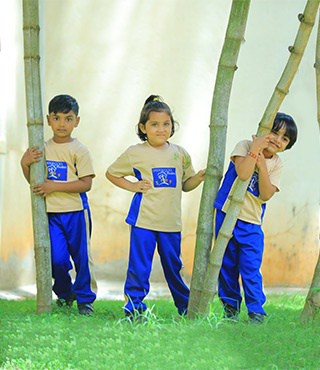
Virtual Learning – The New Age Classrooms at Home?
Virtual Learning – The New Age Classrooms at Home?
What is the first thing that comes to your mind when you think of the word classroom?
The beautiful smiling faces of children sitting together and listening attentively to the teacher is what we would picture when the topic of education or learning comes up in general.
However, all of this changed when the World Health Organisation declared COVID-19 as a global pandemic on the 11th March 2020. The virus was spreading like wildfire and in order to contain the further spreading of the disease and loss of life, most governments around the world, including India, authorized unprecedented social containment measures to curb the waves.
Among the many measures required for social distancing also came the temporary physical closure of schools and educational institutions, because of which over 1.2 billion children were out of the classroom globally.
It is because of this, and the uncertainty of the situation, that the education system around the globe was forced to find alternative means of education, to secure the future of children.
Virtual learning came as a boon that allowed secure learning without affecting children’s education while keeping the children within the safety of their own households.
Though initially the transition from the physical classroom to online classes was quite abrupt and children, teachers and administrators were not so well prepared to build emergency remote learning systems almost immediately, online education enabled that students’ education was not hindered, despite the difficult circumstances.
So what is virtual learning?
In general, it is an education that takes place outside the school.
Virtual learning means creating an online environment as a way of connecting pupils and educators using web-based platforms that are designed to extend and replicate educational experiences as best as possible.

Students access resources and interact with their teachers and educators in a similar manner as in a physical classroom, by harnessing technology to supplement and give an in-class experience such as PPTs, course plans, virtual boards, and so on.
Benefits of virtual learning:
In the initial stages of the pandemic, when people were grappling with the whole situation, most of them were ill-equipped with knowledge about the transition or the digital switch in the field of education.
With most educational institutions and governments as well pondered on how to proceed with education as the COVID-19 pandemic was prolonging the delay in learning tremendously. Online mediums of education came as a ray of hope to many children who could continue learning and growing with the help of online education.
It is almost surrealistic to see how feasible and easy technology has made online education at such a crucial time of need. The tremendous speed with which online education has evolved from the beginning of the pandemic till now, i.e. almost 2 years since the beginning of the pandemic is spell bounding.
The lesson plans and courses have become more comprehensive and detailed with well-planned class structures and materials put in place, enabling students to receive the required help despite them missing one or two online sessions. We can see how teachers and educators are working tirelessly on improvising and adding to their skills to improve and impart better quality education every day.
Also, online classes give children more attention as there are only so many children in the class when compared to typical off-line learning practises in most cases. The convenience of learning from home also makes education accessible without the risks, costs and time of travelling and reduces pressure on time management.

Apart from these, one of the major benefits is that children are allowed to save lectures and repeat them from time to time for taking notes or cross-referencing with the recording option features for their lectures. Therefore, Virtual learning has also enabled children to study at their own pace, while also giving them a chance to personalize their curriculum, which is atypical in face-to-face learning.
Drawbacks of virtual learning:
Educational institutions in India are vastly based on traditional methods of learning, such as face-to-face classroom teaching. It is only when the pandemic struck that various areas of online teaching were explored.
In spite of virtual learning being the only option when compared to having no learning at all which would cause a major interruption in education and student learning with long-lasting consequences, the sudden shift to digital platforms, lead to suboptimal results in comparison to regular education. This shift in digital learning posed a new set of challenges for the educators and students to learn effective ways in order to continue education in a manner that was as close to face-to-face learning as possible.
One of the major concerns in online learning is that it is available only to children that have access to the internet or a broadband connection that is good enough to support online learning effectively.
Many children still face challenges despite the availability of the internet, such as internet connectivity issues, problems with audio and video, accessing technological devices at home, having multiple classes, having 2 or more children, and not having enough devices to support online education, such as laptops, desktops, phones are all very common in most of the places even in urban India.
However, the disruption of education caused by the pandemic adversely affected many rural places in India, where children could not attend any classes at all owing to a lack of adequate digital infrastructural support.
It is this rural Indian population, which is a catalyst to improve the economic and social well-being and the overall development of the nation. According to the annual state education report survey, two-third of rural children reported that they did not receive any educational materials or learning activities at all in India during the entire period of the pandemic, as reported by India Today.

Another major disadvantage of virtual learning is the lack of face-to-face interaction with educators and peers in real-time. It is said that students’ attitudes and dispositions are greatly influenced by the support they receive from their teachers and peers they are exposed to. Different forms of support from teachers, such as emotional support and encouragement or enthusiasm shown by the teachers are all found to be extremely important in the development of positive attitudes towards learning. This personal touch to teaching can face setbacks when it comes to an online mode of communication or teaching, to a certain degree.
Also, students may find it tiring, boring, or even daunting to sit before the screen for such long hours, so the lessons need to be shortened as compared to the elaborate in-class teaching. The majority of learning that requires practice and implementation does not reach its full potential unless children can practice what they learn. As the majority of online content is theoretical and the lack of access to labs and practical applications will cause major concern in subjects that especially require practical experience.
Summing up:
While virtual learning comes with its multifaceted benefits and certain limitations, governments and institutions need to take measures to help children and educators overcome such challenges. When the pandemic and its consecutive lock-downs and restrictions of movement served as an inflection point in academics around the globe, the presence of online academics has been critical to the sustenance of learning in the present scenario.
As one of the top ICSE schools in Bangalore, Sherwood High believes in working towards accelerating progress in empowering our students to fulfill their academic and professional passion to the best of our abilities, with the help of our dynamic faculty dedicated to making the whole virtual learning experience fully effective.
Therefore, we are trying our best to teach through a set and organized curriculum, while teaching with the help of our experienced faculty, which makes learning several times fun, easier, and a lot more engaging for the students, even in an online situation.
As we understand that children are bound to lose interest in long sessions, our lesson plans are made in a manner where the teaching does not prolong for long hours but are rather short, crisp, and engaging while also encouraging our children to take an active part and interact throughout our sessions.
So we conclude by saying that with the uncertainty about when schools will resume physically, the online sector of education and its development has been the best bet for receiving education to a great extent. Though the transition to virtual learning was rather abrupt, the sharp and competent growth of online classes has proven that virtual learning is indeed what is keeping us hopeful during these testing times.






